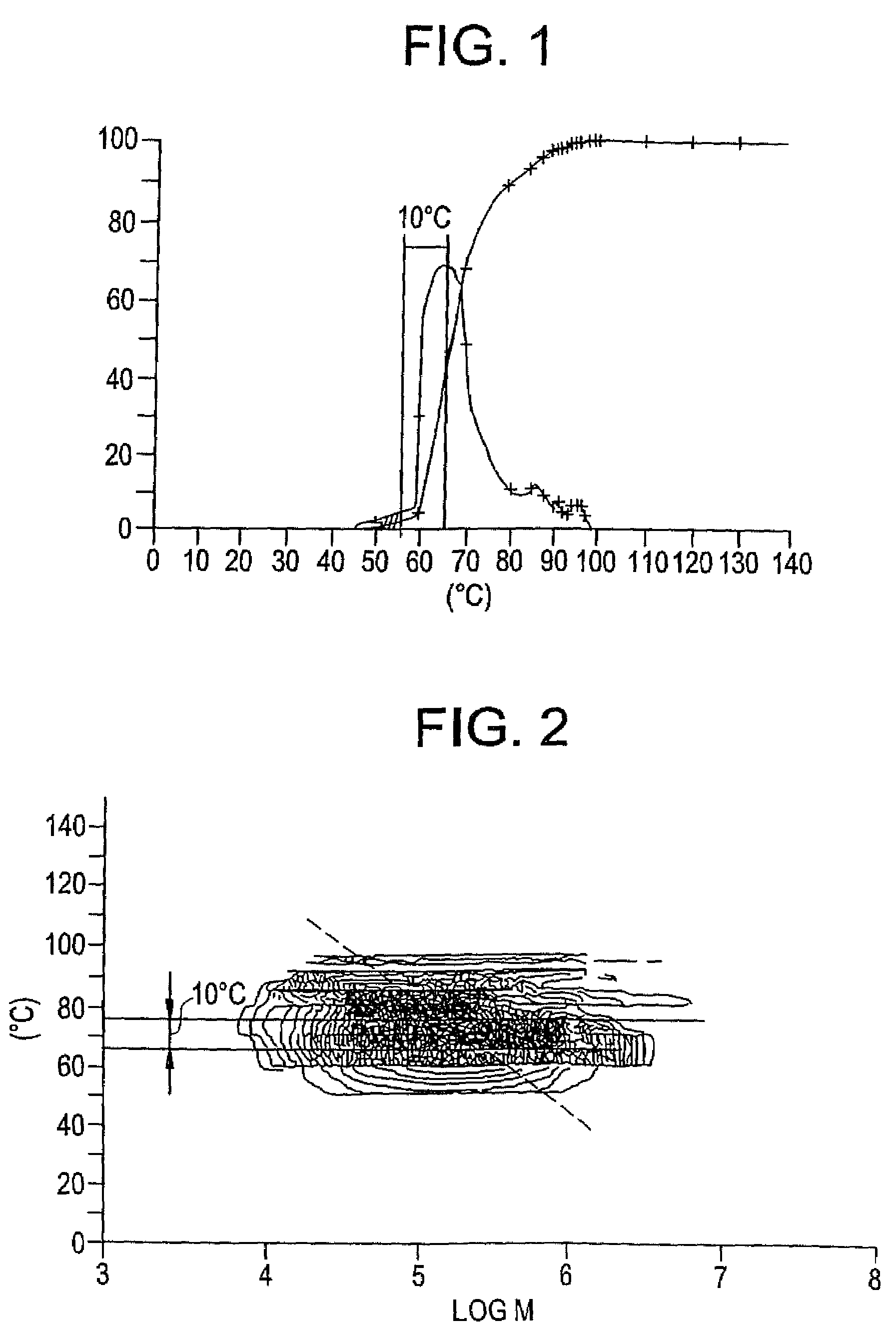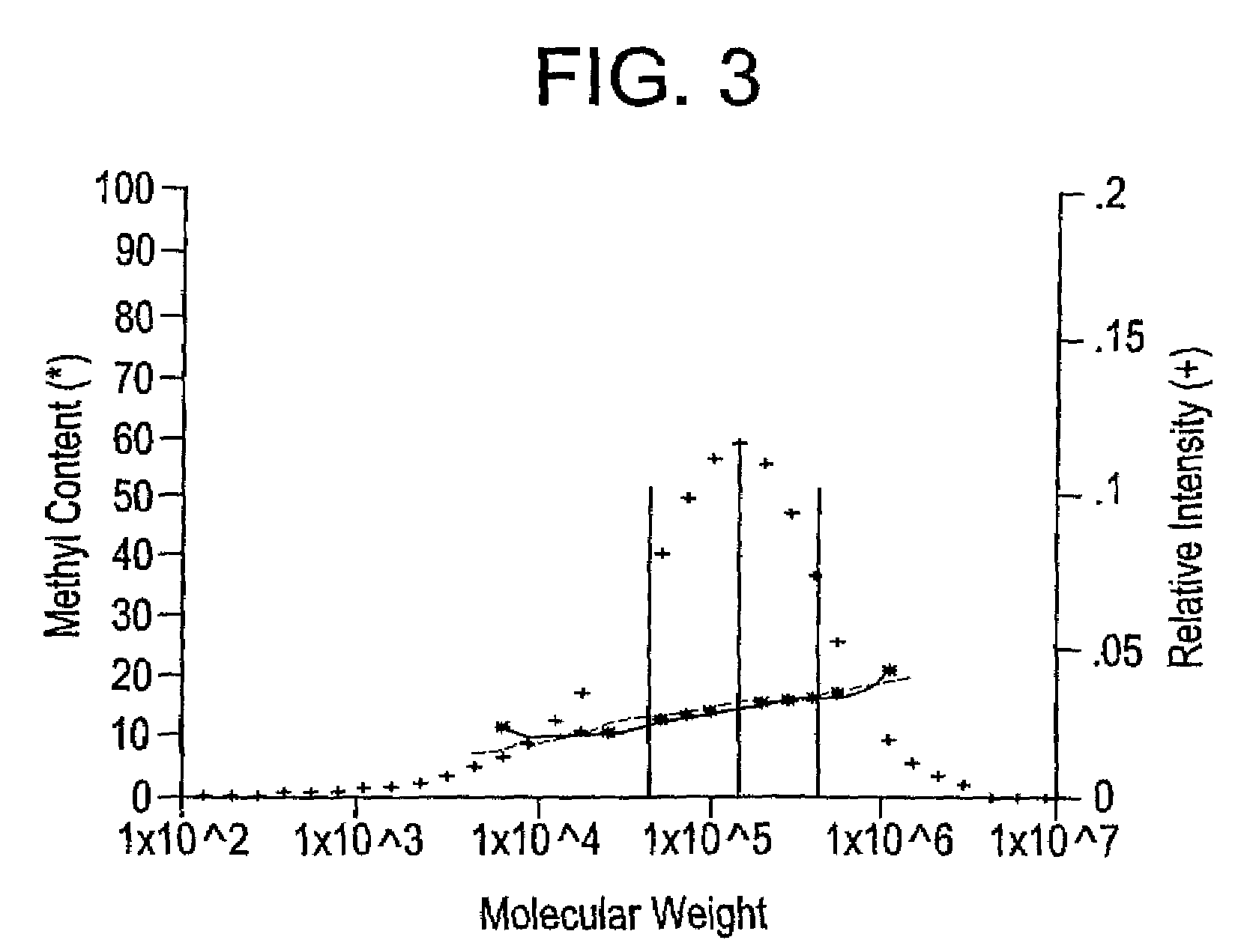Ethylene copolymers and blend compositions
a technology of ethylene copolymer and blend composition, applied in the field of ethylene copolymer, can solve the problems of loss of performance in one, loss of toughness, escr, low optical properties, etc., and achieve excellent balance and uniform properties, high impact strength, and excellent escr
- Summary
- Abstract
- Description
- Claims
- Application Information
AI Technical Summary
Benefits of technology
Problems solved by technology
Method used
Image
Examples
example 1
[0468]20 g of silica SP-9-10046 (manufactured and sold by Grace GmbH, Germany), which had been treated at 250° C. for 2 hours under vacuum, was slurried in 250 ml of toluene. To the resultant slurry was added a solution of 20 ml (0.11 mol) of triethylaluminum in 100 ml of toluene. The resultant mixture was stirred for 2 hours, filtered, washed with two 100 ml portions of fresh toluene and dried under vacuum. The resultant 22 g of dried mixture was slurried in 300 ml of toluene and heated to 70° C. to thereby obtain a slurry. To this slurry was added a solution of 1.25 g (1.77 mmol) of triethylammonium tris(pentafluorophenyl)(4-hydroxyphenyl)borate in 200 ml of toluene which had been heated to and maintained at 70° C. for 30 minutes. Upon addition the heating was removed and the resultant mixture was stirred for 3 hours. After that, a 12.3 ml aliquot of a dark violet colored 0.0714M solution of titanium (N-1,1-dimethylethyl)dimethyl[1-(1,2,3,4,5,-eta)-2,3,4,5-tetramethyl-2,4-cyclopen...
examples 2 and 3
[0471]25 g of silica SP-9-10046 (manufactured and sold by Grace GmbH, Germany) having a water content of 3.5% by weight was added to 508 g of 10% methylalumoxane solution in toluene (manufactured and sold by Witco GmbH, Germany) while continuously stirring. The mixture was stirred for a further two hours and then the solvent was removed under reduced pressure at 20° C. to yield a free-flowing powder. The resulted free-flowing powder was then heated at 175° C. for two hours under vacuum. The resulting powder was re-slurried in 700 ml of toluene and the mixture was washed with two portions of fresh toluene at 100° C. The support was then dried under vacuum at 120° C. for 1 hour. 63.9 g of support was obtained having an aluminum content of 26.4% by weight.
[0472]To 60 gram of the support was added a 33.6 ml aliquot of a dark violet 0.0714 M solution of titanium (N-1,1-dimethylethyl)dimethyl[1-(1,2,3,4,5-eta)-2,3,4,5-tetramethyl-2,4-cyclopentadien-1-yl]silanaminato[(2-)N]-(eta 4-1,3-pent...
examples 4 to 6
[0474]Substantially the same procedures were used as in Examples 2 and 3 to produce the supported catalyst, except that a different MAO treated silica was used wherein the MAO was also immobilized on the silica, but using a different method.
[0475]Substantially the same polymerization procedures as in Example 1 were used, except that the polymerization temperatures and the flow rates of isopentane, 1-butene and hydrogen were changed as indicated in Table 1. The gradient and CFC 1 and CFC 2 data for Examples 4-6 are extrapolates, based on density, from the results of Example 1-3.
[0476]The results of the reactions are shown in Table 1.
PUM
| Property | Measurement | Unit |
|---|---|---|
| temperature | aaaaa | aaaaa |
| temperature | aaaaa | aaaaa |
| temperatures | aaaaa | aaaaa |
Abstract
Description
Claims
Application Information
 Login to View More
Login to View More - R&D
- Intellectual Property
- Life Sciences
- Materials
- Tech Scout
- Unparalleled Data Quality
- Higher Quality Content
- 60% Fewer Hallucinations
Browse by: Latest US Patents, China's latest patents, Technical Efficacy Thesaurus, Application Domain, Technology Topic, Popular Technical Reports.
© 2025 PatSnap. All rights reserved.Legal|Privacy policy|Modern Slavery Act Transparency Statement|Sitemap|About US| Contact US: help@patsnap.com



